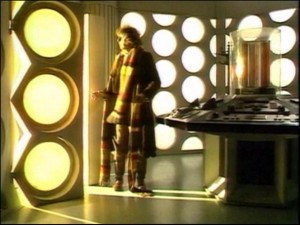 A new season for Dr Who, and a much-improved start over the way the last season ended. The difference is glaring when going through these episodes one per week (it would probably have been less so for original viewers, who would have come to this story after a several months’ hiatus between seasons).
A new season for Dr Who, and a much-improved start over the way the last season ended. The difference is glaring when going through these episodes one per week (it would probably have been less so for original viewers, who would have come to this story after a several months’ hiatus between seasons).
Part of the credit goes to the fact that during the hiatus, Robert Holmes discovered he hadn’t been barred from writing for the BBC after all, and he returns to pen this season-16 opener. There’s also the fact that, here at the start of the season, the production team is out from under the money crunch that absolutely killed the last couple of stories. Everything in this story looks good, from the well-decorated sets to the elaborate costumes. The story is entirely studio-bound, no location shooting, which would have saved the production money even so, which may be a sign that Graham Williams is going to be more careful this year to save some of the budget for the late-season episodes (we’ll have to keep an eye on that as we go forward).
Perhaps the most interesting thing about this season opener is that it launches Dr Who’s first season-long story arc (one of only 2 in the Classic series). Season 16 as a whole is going to be the story of the search for the Key to Time. As the story opens, the Doctor has just finished putting together his new K-9 (Mark II) when some powerful entity stops the TARDIS in mid-flight, and the doors open to admit a flood of light from outside. The stunned Doctor realizes that “only a Guardian” could do that and indeed it turns out the White Guardian wants a word. He tells the Doctor about the Key to Time, an artifact of ultimate power that allows its possessor total control over time itself. The prevent its misuse, the Key has been broken into six segments, scattered across all of time and space, which could be disguised as any object. Now some sort of universal crisis is approaching and the Doctor must find all 6 segments and return them to the White Guardian so that he can temporarily “stop everything” while he fixes whatever’s going wrong.
To guide the Doctor’s quest, the White Guardian gives him the Key’s “Core,” a wand-like device which, when plugged into the TARDIS console, will steer it to the time and place the next segment is to be found. After landing, it will home in on the segment and, when touched to the disguised segment, will cause it to revert to its true form. The Guardian also warns the Doctor that there is a Black Guardian who desires the Key for evil purposes, and he must not be allowed to get it.
It’s an intriguing start to the season, especially as we soon realize the search for the six segments is more than just the subject of this particular episode: as we get under way, it becomes clear that it’s going to be one adventure per segment, and the Key to Time story will last us through the whole season.
The coordinates for the first segment take the Doctor and his new assistant, Romana (see below) to the planet Ribos, a world at a medieval level of both technology and society, but lying within the territory of the “Greater Cyrrhenic Empire.” The attempt to retrieve the segment soon involves the Doctor and Romana in an elaborate “heist movie” story involving con artists Garron and Unstoffe and their intended mark, the villainous Graf Vynda-K.
Robert Holmes’ skills in both science fiction world-building and in the creation of memorable characters are on display in the script. Both the feudal Ribos society and the politics of the Cyrrenhic empire are made clear in brief bits of well-placed dialog, no lengthy expositional scenes needed, and the characters delivering those lines are themselves interesting an layered. None of them are quite as delightful as the Jago & Litefoot pairing of a few episodes back, but they’ve all got well-drawn personalities that let us understand what they do and why.
I’ll single out for special mention a surprisingly moving scene that occurs in the middle of the story. On the run from the guards, Garron’s sidekick Unstoffe meets an old beggar named Binro who helps him to hide. Hearing the beggar addressed as “Binro the Heretic,” Unstoffe asks what that means and Binro, at first reluctantly, reveals that he is essentially the Galileo of Ribos: once he was a scholar, and he proposed the idea that Ribos moves around its Sun instead of the Sun moving around Ribos. For that heresy he was tortured, forced to recant, and left as a homeless beggar. Moved by the story, and by the old man’s willingness to risk even more trouble by hiding him, Unstoffe reveals that he comes from another world, that Binro’s theory is correct, and that “I know that one day, even here, men will turn to each other and say ‘Binro was right.’” The old man clutches Unstoffe’s hands, weeping with gratitude.
Binro goes on to play a relatively minor role in the rest of the story, but that one scene makes sure we care about him. That is how you write characters that make your story matter.
The New Assistant
 To help the Doctor in the quest for the Key to Time, the Guardian gives him a new assistant, the Time Lady Romanadvoratrelundar. The Doctor quickly shortens her name to Romana (“by the time I finish saying ‘Look out, Romanadvoratrelundar’ you could be dead”).
To help the Doctor in the quest for the Key to Time, the Guardian gives him a new assistant, the Time Lady Romanadvoratrelundar. The Doctor quickly shortens her name to Romana (“by the time I finish saying ‘Look out, Romanadvoratrelundar’ you could be dead”).
Played by actress Mary Tamm, Romana starts out as decidedly haughty and, though she doesn’t (quite) say so, is pretty confident that she could handle this whole Key to Time business much better than the Doctor could. She starts right off offending him by installing the socket for the Core while he’s out talking to the Guardian (“A hole! You put a hole in my TARDIS!”) and then goes on to point out that she graduated the Academy with a “triple first” while he barely scraped by with 51 percent on his second attempt.
The Doctor gets to score his own points when the adventure gets under way and Romana is forced to realize that his practical experience may come in more handy out in the Universe than her report card, but as this story ends both she and the Doctor have a ways to go before deciding they like each other.
Details
- Romana believes she was assigned to this mission by the President of the High Council of Time Lords, which the Doctor takes to mean he’s not supposed to tell her that the Guardians are involved. It also suggests that the Time Lords moved quickly to install a new President after the events of The Invasion of Time. In that episode, the Doctor returned after a lengthy absence to claim the presidency because Time Lords’ glacial pace of government meant they hadn’t gotten around to electing anyone else yet. The events of that story must have convinced them that this time they needed to get on with it.
- There are a few chinks in the armor of Robert Holmes’ world-building. Though supposedly protected and unaware of the wider galactic civilization around them, Ribos apparently uses the same unit of currency as the Cyrrhenic empire (a gold coin called an “Opik” [spelling uncertain]). The Graf Vynda-K and his soldiers dress in a medieval style that fits right in on Ribos, but it doesn’t appear to be the result of trying to blend in— they don’t look like the clothes worn by the people of Ribos, they’re just similarly medieval in style. Shouldn’t aliens to the planet at least dress a little more… alienly?
- Another question surrounds a lump of “jethryk” Garron is using in his con game. Jethryk, we’re told, is a supremely rare and valuable mineral, and convincing Vynda-K that it is abundant on Ribos is part of Garron’s con. But Garron’s sample of it needs examination. Both the Doctor and Vynda-K are astonished by it, separately saying it’s the largest piece they’ve ever seen. Vynda-K adds that this single piece alone is enough to power a hundred battle fleets, and the implication is it’s worth more than the whole price Garron is trying to extract from selling mineral rights to Ribos. It’s clear that Garron, although he knows it’s valuable, has no idea of the true value of the jethryk sample he’s using for his con (Vynda-K says as much at one point). But this raises all sorts of questions. What is a two-bit con artist like Garron doing with it? For comparison, this is like some grizzled prospector trying to sell a fake map of a diamond mine using the Cullinan diamond as his bait (check Wikipedia). We eventually find out that Garron stole it from “some guy” but that’s hardly an adequate explanation.
- I can make up an explanation: it was found by someone who, like Garron, had no idea of its true value and who therefore, like Garron, carried it around more casually than he should have. Since (spoiler warning) we eventually learn it is the disguised segment of the Key to Time, that’s perhaps plausible. It could have just appeared somewhere outside of the places where more knowledgeable miners look for jethryk. But something should have been said about it.
- We get the first definitive statement of the Doctor’s age in quite a while. The Second Doctor once claimed to be 450, and now the Fourth Doctor says he’s 756 (although Romana tells him he’s lost count somewhere and that according to his data file, he’s 759). If the Doctor’s had 300 years go by since the Patrick Troughton era, then we certainly have not seen all his adventures.
- Which raises the question of exactly when did those adventures fall? Since the Doctor normally travels with human companions, who certainly didn’t age 300 years while we saw them, we can only squeeze in at most a few unseen years during those times. The bulk of the time must have happened in between the departure of one companion and the arrival of the next— leading to the intriguing picture of whole additional eras of the Doctor’s life, including other people he traveled with, that we’ve never seen (considerably longer, in fact, than the total of all his adventures that we have seen).
Next Week
“The Pirate Planet,” 4 episodes.

